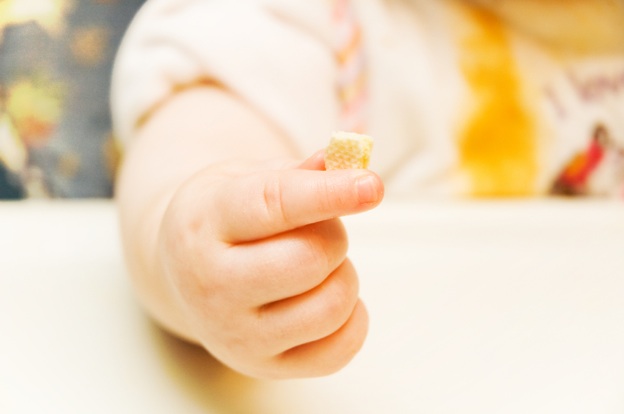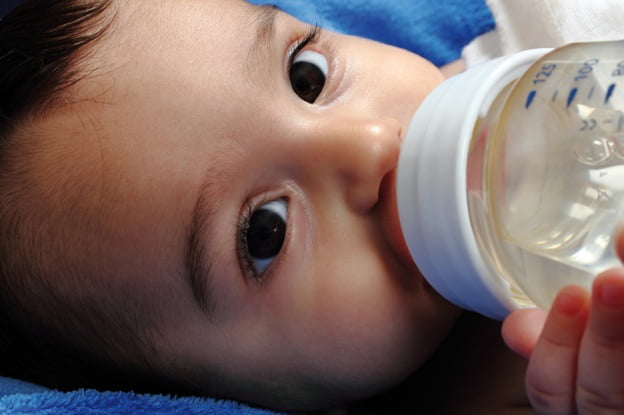SingaporeMotherhood | Baby & Toddler
July 2013
Weaning: Let Baby Lead

My daughter was exclusively breast fed from birth. When she turned six months old, I excitedly introduced her to pureed foods to complement the breast milk in her diet.
However, my baby girl had food sensitivities. Meals were quickly followed by episodes of projectile vomiting, diarrhoea and inconsolable crying.
[banner][/banner]
If she ate something that she could not tolerate and experienced severe tummy symptoms, she would refuse to breastfeed or eat any solid food. After a day or two, she would begin breastfeeding. After a further few days, she would cautiously accept food, eating a few spoonfuls.
This cycle continued for a couple of months, amidst lots of confusion, doubt and some mommy-guilt. Had I ‘pushed’ her to accept solid food before her body was ready, I wondered.
Now, the World Health Organization (WHO), the United Nations Children’s Fund (UNICEF) and several paediatric organisations recommend exclusive breastfeeding for the first six months of life, not just for the first four to six months, as is commonly believed.
During the period from birth to sometime between four and six months of age, babies’ digestive tracts are more vulnerable to large protein molecules from foods that trigger allergies or pathogens. Prolonged exclusive breastfeeding reduces the risk of food allergies.
During the early months, antibodies in breast milk coat the baby’s gastrointestinal tract, preventing absorption of allergy-triggering substances or microbes. By six months of age, your baby’s body produces sufficient amounts of these antibodies, and his digestive system would have matured.
So for my subsequent babies, I delayed the introduction of solid foods, waiting until they were seven months old, or later.
I wanted breast milk to remain my babies’ main source of nutrition during their first year. I did not want nutritionally superior breast milk to be displaced by solid foods.
Babies who start solids early or eat large amounts of solids tend to wean from breastfeeding earlier. I was eager to hold off on that for a while longer!
So I took a more baby-led approach to weaning for my later kids. I realised that my babies are instinctively aware of what works for their bodies. This thinking is echoed by Gill Rapley and Tracey Murkett in their 2010 book, Baby-Led Weaning: The Essential Guide to Introducing Solid Foods – and Helping Your Baby to Grow Up a Happy and Confident Eater. This is what it involves:
A Diet of Exploration
Rapley describes baby-led weaning as a logical way to introduce solid foods to a baby. Baby-led weaning involves offering finger foods and letting baby set his own pace by self-feeding. The emphasis is on exploring new tastes and textures.
An Ideal Transition
Both breastfeeding and baby-led weaning put the baby in the driver’s seat. With breastfeeding, the baby regulates how much milk he takes in and how long he nurses for. In baby-led weaning, the baby also manages his own food intake.
Trusting, and Letting Go
Another similarity between breastfeeding and baby-led weaning is the need for the mother to trust in Nature’s design. This means that I have had to let go of my desire to control the amounts of breast milk or the food consumed, and relax about the numbers!
Also for Bottle-fed Babies
Baby-led weaning also works for bottle-fed babies. The only thing to note is that parents have to ensure that adequate fluids (besides milk) are offered to the baby, says Gill Rapley in her article, ‘Guidelines for Implementing a Baby-led Approach to the Introduction of Solid Foods’. Offer water regularly to your baby once he begins eating small amounts of food. He will drink as he needs to.
No Spoon-feeding
Baby-led weaning occurs after baby turns six months of age, thus bypassing the spoon-feeding and purees stage. This takes the fuss out of baby meal preparation as you simply offer table foods to an older baby at family mealtimes.
Develops Coordination
Self-feeding and eating finger foods help develop Baby’s hand-eye coordination, finger control, and chewing skills. This form of (edible!) exploratory play also keeps mealtimes fun and relaxed. Of course, this has meant taking the subsequent housekeeping challenges in stride!
No Worries about Choking
Babies weaned on purees are often offered finger foods at about eight months of age. In baby-led weaning, solid foods are introduced through finger-feeding, after six months of age. Gill Rapley explains that babies reduce their risk of choking when they are in control of what goes into their mouths. A very young baby will not have the developmental ability to pick up small pieces of food that could cause choking.
In this light, it is important not to put food into the baby’s mouth in an effort to ‘help’ him eat more. Choking can also be prevented by sitting baby upright when he is handling food, avoiding whole nuts, and cutting small, round foods such as grapes in half.
Starting Foods
Fruits and vegetables such as sliced pieces of avocado or mango are ideal first foods. Harder foods can be lightly steamed. Foods should be cut into baby fist-sized pieces, not mouth-sized pieces. This makes them easier for baby to hold.
For meats, begin with large pieces for Baby to mouth, moving on to minced meat when Baby is able to pick up fistfuls of food by himself. Chunks of cheese, eggs, or pasta add variety to a baby’s diet. Avoid adding sugar and salt, and junk foods!
The doctors Sears explain in their book, The Healthiest Kid in the Neighbourhood, that there are connections between early childhood eating and adult health. What they term ‘metabolic programming’ explains how the food that kids eat affects how their cells are programmed to do their work. This in turn affects growth, development and organ functioning.
They also explain the connection between early childhood nutrition and adult health. A childhood diet high in junk carbohydrates and fats damages the lining of blood vessels, leading to high blood pressure, strokes and poor heart health in adulthood.
So it helps to stay mindful that even as we shape our young ones’ ideas about eating right from babyhood, we are influencing their food choices for their lifetimes.
All content from this article, including images, cannot be reproduced without credits or written permission from SingaporeMotherhood.
Follow us on Facebook, Instagram, and Telegram for the latest article and promotion updates.






